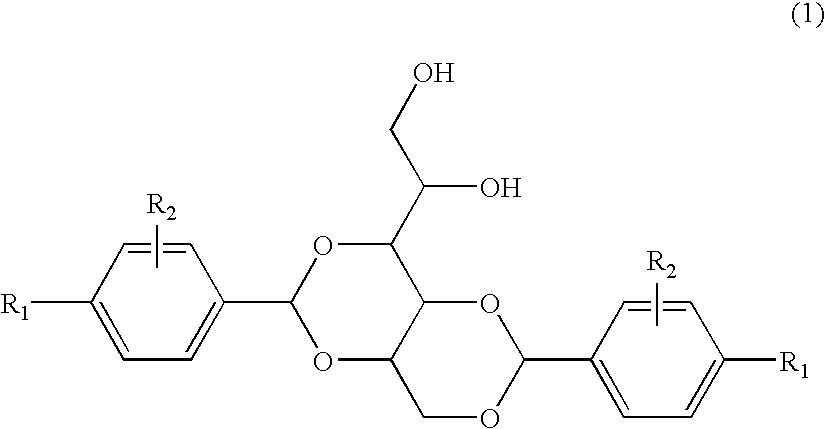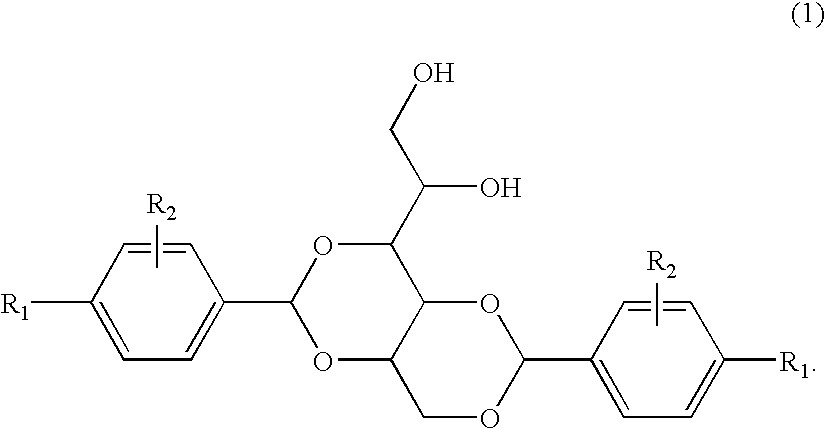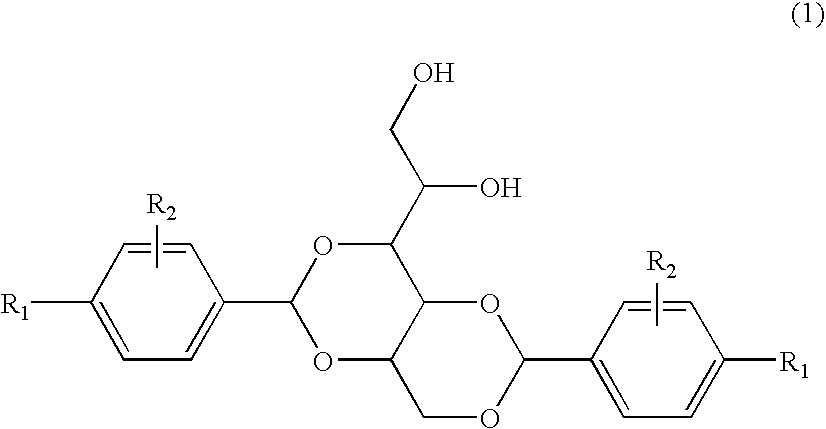Biodegradable Resin Compositions and Molded Objects Thereof
a technology of biodegradable resin and composition, which is applied in the direction of detergent composition, detergent compounding agent, chemistry apparatus and processes, etc., can solve the problems of toxic gas generation, shortage of landfill sites, and heavy load on the global environment of waste plastic, so as to improve the physical property balance, improve or increase the impact resistance, and improve the compatibility between the respective components. , the effect of improving or increasing the impact resistan
- Summary
- Abstract
- Description
- Claims
- Application Information
AI Technical Summary
Benefits of technology
Problems solved by technology
Method used
Image
Examples
production example 1
[Production of a Polyorganosiloxane Latex (S-1)]
[0187] A siloxane mixture (100 parts) was prepared by mixing up 1 part of tetraethoxysilane, 1.5 parts of γ-methacryloyloxypropyldimethoxymethylsilane and 97.5 parts of octamethylcyclotetrasiloxane. The mixed siloxane (100 parts) was added to a solution of 1 part of sodium dodecylbenzenesulfonate and 1 part of dodecylbenzenesulfonic acid in 200 parts of distilled water. After preliminary stirring in a homomixer at 10,000 rpm, emulsification and dispersion were effected in the homogenizer at a pressure of 300 kg / cm2 to give an organosiloxane latex. This liquid mixture was transferred to a separable flask equipped with a condenser and a stirring blade, heated at 90° C. for 5 hours with stirring / mixing and then allowed to stand at 20° C. After 48 hours of standing, the latex was neutralized to pH 7.5 with an aqueous solution of sodium hydroxide. The polymerization was thus completed, and a polyorganosiloxane rubber latex (S-1) was obtain...
production example 2
[Production of a poly(alkyl acrylate) latex (R-1)]
[0188] A five-necked flask equipped with a stirrer, reflux condenser, nitrogen inlet, additional monomer feeding port and thermometer was charged with 200 parts of pure water, 1.5 parts of sodium rosinate, 0.4 part of Rongalite (SFS), 0.01 part of ethylenediaminetetraacetic acid disodium salt (EDTA) and 0.0025 part of ferrous sulfate all at once. The system temperature was raised to 40° C. with stirring in a nitrogen atmosphere and, after arrival at 40° C., a mixture composed of 100 parts of butyl acrylate (BA), 1 part of allyl methacrylate (AlMA) and 0.1 part of cumene hydroperoxide (CHP) was added dropwise continuously over 6 hours. After completion of the dropping, the whole mixture was stirred at 40° C. for 1 hour to complete the polymerization. The polymerization conversion rate was 97%. The latex obtained had a pH of 8.2, a solid concentration of 32%, an average particle diameter of 80 nm, and a gel content of 99%.
production example 3
[Production of Composite Rubbers]
(SR-1)
[0189] An amount, corresponding to 10 parts of solid matter, of the above-mentioned polyorganosiloxane rubber latex S-1 was taken and placed in a separable flask equipped with a stirrer, 180 parts of distilled water was added and, after nitrogen substitution, the temperature was raised to 40° C. The flask was then charged with a liquid mixture consisting of 65 parts of n-butyl acrylate, 0.65 part of allyl methacrylate and 0.065 part of CHP, the whole mixture was stirred for 30 minutes to thereby allow the liquid mixture to permeate through the polyorganosiloxane rubber particles. Then, the flask was charged with a liquid mixture composed of 0.0025part of ferrous sulfate, 0.01 part of EDTA, 0.3 part of SFS and 5 parts of distilled water to initiate the radical polymerization. The inside temperature was maintained at 70° C. for 2 hours to drive the polymerization to completion, and a composite rubber latex was obtained. A part of this latex wa...
PUM
| Property | Measurement | Unit |
|---|---|---|
| Percent by mass | aaaaa | aaaaa |
| Percent by mass | aaaaa | aaaaa |
| Percent by mass | aaaaa | aaaaa |
Abstract
Description
Claims
Application Information
 Login to View More
Login to View More - R&D
- Intellectual Property
- Life Sciences
- Materials
- Tech Scout
- Unparalleled Data Quality
- Higher Quality Content
- 60% Fewer Hallucinations
Browse by: Latest US Patents, China's latest patents, Technical Efficacy Thesaurus, Application Domain, Technology Topic, Popular Technical Reports.
© 2025 PatSnap. All rights reserved.Legal|Privacy policy|Modern Slavery Act Transparency Statement|Sitemap|About US| Contact US: help@patsnap.com



